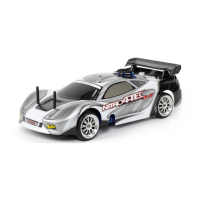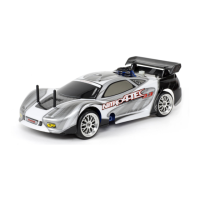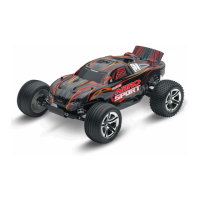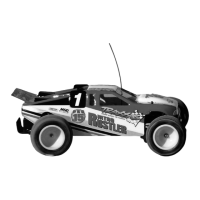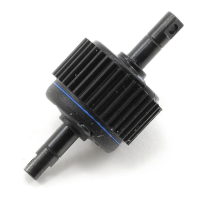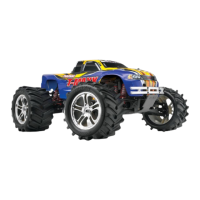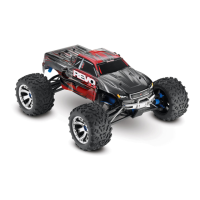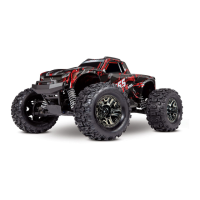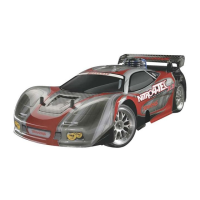
Do you have a question about the Traxxas Nitro 4-Tec 3.3TM all-wheel-drive 4809 and is the answer not in the manual?
| Scale | 1/10 |
|---|---|
| Engine | TRX 3.3 Racing Engine |
| Top Speed | 70+ mph |
| Fuel Tank Capacity | 75 cc |
| Drive System | All-Wheel Drive |
| Fuel Type | 20% Nitro |
| Radio System | Traxxas TQi 2.4GHz |
| Length | 431 mm (17 inches) |
| Wheelbase | 257 mm (10.12 inches) |
| Suspension | Independent |
| Shocks | Oil-filled, threaded aluminum shocks |
| Differential | Sealed differentials front and rear |
| Transmission | 2-speed automatic transmission |
| Servos | High-Torque Waterproof |
| Body | ProGraphix Painted |
| Recommended Fuel | Traxxas Top Fuel 20% Nitro |
Provides contact information and support options for Traxxas products.
Guides users through essential steps to get the model running quickly.
Explains icons used in the manual for warnings, tips, and references.
Details Traxxas customer support contact information and services.
Highlights crucial safety guidelines and warnings for operation.
Lists tools and equipment included with the model.
Lists necessary items to purchase separately for operation.
Lists optional accessories available for purchase.
Instructions on how to apply decals to the model's body.
Guidance on attaching the body mounting hardware.
Details the controls and features of the TQ radio transmitter.
Illustrates the electrical connections within the Nitro 4-Tec.
Defines key terms related to the radio system.
Instructions for installing batteries in the transmitter.
Advice on selecting and using appropriate batteries for the transmitter.
Steps for installing batteries in the receiver.
Information on the optional rechargeable power system.
Guide on correctly installing and positioning the antenna.
Explains the functions of the transmitter's controls and adjustments.
Details how to adjust throttle trim, steering trim, and reverse switches.
Outlines essential rules for safe and proper radio system operation.
Instructions on operating the TQ radio system.
Procedure for testing the radio system's range before use.
Overview of the engine's features and design.
Explains the critical break-in procedure for engine longevity.
Importance and procedure for maintaining the air filter.
Steps for post-run engine care to prevent corrosion.
A diagram labeling all major engine components.
Glossary of terms used for the Nitro R/C engine.
Discusses fuel types, nitro content, and selection for the engine.
Emphasizes using the correct fuel for optimal performance and engine life.
Explains the impact of different nitro percentages on engine performance.
Discusses the use of non-Traxxas fuels and potential drawbacks.
Provides safety guidelines for handling and storing fuel.
Step-by-step instructions for filling the model's fuel tank.
Importance of the air filter and how to maintain it.
Detailed procedure for cleaning and oiling the air filter.
Explains the function and components of the carburetor.
How the carburetor controls speed via air/fuel mixture.
Details the high-speed and low-speed needles for tuning.
Recommended initial settings for carburetor needles.
How to adjust the idle speed using the idle speed screw.
Introduction to the EZ-Start electric starting system.
Steps for installing and charging the EZ-Start battery.
Advice on choosing and using the correct charger for batteries.
Instructions on how to operate the EZ-Start system.
Explains the EZ-Start's protection mode and how to reset it.
Importance of a charged battery for EZ-Start operation.
Procedure for safely shutting down the engine.
Detailed instructions for the engine break-in procedure.
Steps to start the engine for the very first time.
Break-in procedure for the first tank of fuel.
Break-in procedure for the second tank of fuel.
Break-in procedure for the third tank of fuel.
Break-in procedure for the fourth tank of fuel.
Break-in procedure for the fifth tank of fuel.
Guidance for tuning the engine after the initial break-in.
Advice for performing break-in in cold weather conditions.
General guidance on tuning the engine for optimal performance.
Identifies symptoms of overheating and lean mixtures.
How to address fluctuating idle speed issues.
Detailed steps for adjusting the high-speed fuel mixture.
Procedure for adjusting the low-speed fuel mixture using the pinch test.
Chart showing how atmospheric conditions affect fuel mixture.
How to adjust the idle speed for reliable running.
Making fine adjustments to the carburetor after initial tuning.
Using temperature as a guide for engine tuning.
Essential tips and warnings before driving.
Steps to adjust the two-speed transmission's shift point.
Recommended alignment settings for optimal tire wear and handling.
How to adjust wheel camber for better handling.
Instructions for setting the front wheel toe-in.
How to adjust shock absorbers for optimal handling.
Procedures for adjusting drive belt tension.
Information on changing gear ratios for performance.
Steps to replace the clutch bell gears.
Procedure to re-center servos after service.
Maintenance tasks to perform after each hour of operation.
Post-session checks and maintenance tasks.
Additional periodic maintenance tasks for the engine.
Detailed steps for after-run maintenance to protect the engine.
How to resolve an engine piston stuck at TDC.
Procedure to clear excess fuel from a flooded engine.
Troubleshooting steps for radio system malfunctions.
Solutions for issues causing short radio range.
Diagnosing and fixing EZ-Start issues that prevent engine spin.
Troubleshooting steps when the engine spins but doesn't start.
How to address sluggish engine performance.
